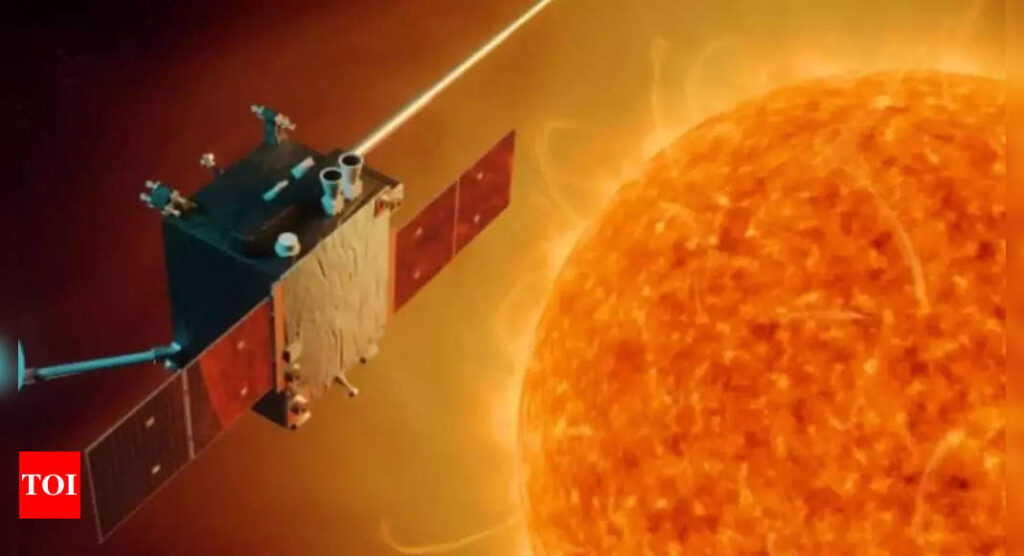[ad_1]
NEW DELHI: Isro’s maiden solar mission Aditya-L1 has captured high energy X-ray glimpse of solar flares for the first time after its launch from Sriharikota on September 2. The spacecraft captured the solar flares while on its way to Lagrange Point L1, where it is likely to reach around January-February.
During its first observation period from approximately October 29, the High Energy L1 Orbiting X-ray Spectrometer (HEL1OS) on board the spacecraft recorded the impulsive phase of solar flares, Isro said in a statement on Tuesday evening.
The recorded data is consistent with the X-ray light curves provided by National Oceanic and Atmospheric Administration’s geostationary operational environmental satellite. Commissioned on October 27, HEL1OS is currently undergoing fine-tuning of thresholds and calibration operations. The instrument is set to monitor the Sun’s high-energy X-ray activity with fast timing and high-resolution spectra. HEL1OS data enables researchers to study explosive energy release and electron acceleration during impulsive phases of solar flares.
HEL1OS, which has been developed by the space astronomy group of Isro’s U R Rao Satellite Centre, is the harbinger of flaring activities on the Sun, with the ability to capture the early impulsive phase of the solar activity.
According to Isro, flares produce enhanced emission in all wavelengths across the electromagnetic spectrum — radio, optical, UV, soft X-rays, hard X-rays and gamma-rays. Flare emission consists of emissions from accelerated particles and hot plasma.
Aditya-L1 spacecraft is designed for providing remote observations of the solar corona and in-situ observations of the solar wind at L1 (Sun-Earth Lagrangian point), which is about 1.5 million kilometres from the Earth.
Besides HELIOS, the six other payloads on aboard Aditya L1 spacecraft are Visible Emission Line Coronagraph, Solar Ultraviolet Imaging Telescope, Solar Low Energy X-ray Spectrometer, Aditya Solar wind Particle Experiment, Plasma Analyser Package For Aditya and Advanced Tri-axial High Resolution Digital Magnetometers.
During its first observation period from approximately October 29, the High Energy L1 Orbiting X-ray Spectrometer (HEL1OS) on board the spacecraft recorded the impulsive phase of solar flares, Isro said in a statement on Tuesday evening.
The recorded data is consistent with the X-ray light curves provided by National Oceanic and Atmospheric Administration’s geostationary operational environmental satellite. Commissioned on October 27, HEL1OS is currently undergoing fine-tuning of thresholds and calibration operations. The instrument is set to monitor the Sun’s high-energy X-ray activity with fast timing and high-resolution spectra. HEL1OS data enables researchers to study explosive energy release and electron acceleration during impulsive phases of solar flares.
HEL1OS, which has been developed by the space astronomy group of Isro’s U R Rao Satellite Centre, is the harbinger of flaring activities on the Sun, with the ability to capture the early impulsive phase of the solar activity.
According to Isro, flares produce enhanced emission in all wavelengths across the electromagnetic spectrum — radio, optical, UV, soft X-rays, hard X-rays and gamma-rays. Flare emission consists of emissions from accelerated particles and hot plasma.
Aditya-L1 spacecraft is designed for providing remote observations of the solar corona and in-situ observations of the solar wind at L1 (Sun-Earth Lagrangian point), which is about 1.5 million kilometres from the Earth.
Besides HELIOS, the six other payloads on aboard Aditya L1 spacecraft are Visible Emission Line Coronagraph, Solar Ultraviolet Imaging Telescope, Solar Low Energy X-ray Spectrometer, Aditya Solar wind Particle Experiment, Plasma Analyser Package For Aditya and Advanced Tri-axial High Resolution Digital Magnetometers.
[ad_2]
Source link











More Stories
Congress replaces Kamal Nath, names an OBC as Madhya Pradesh chief | India News
Fire breaks out in ITBP camp in Srinagar; none hurt | India News
Parliament Security: Co-villagers give clean chit to Lalit Jha, parents to move court | India News